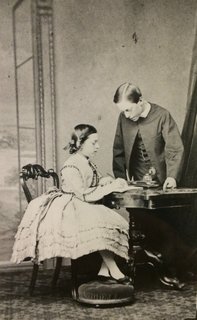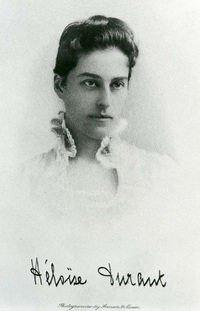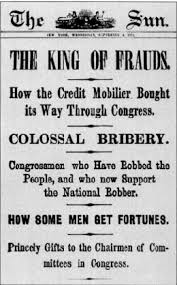 William West Durant and his sister Ella. Isle of Wight 1869. Source: William West Durant Egyptian Diaries.
William West Durant and his sister Ella. Isle of Wight 1869. Source: William West Durant Egyptian Diaries. The tragedy of the lawsuit Ella brought against her brother in 1893 might have been averted if William acted more openly as executor of the Durant estate; and if Ella had not been so assertive in demanding her fair share.
Ella had good reason to be suspicious. William – who had very little money in his bank account at the time he became executor of his father’s estate in 1885 ‘persuaded’ Ella to sign a Power of Attorney, enabling him to take full control of her one-third share of the estate. He quickly accumulated all the visible trappings of wealth, including a large ocean-going yacht built to his own specification at a cost of over $200,000 in 1890. At the same time, he claimed that the value of their father’s estate was minimal and continued to provide Ella with a reasonable but unexpectedly low monthly allowance. Any questions from Ella about the discrepancies tended to result in angry outbursts about her ‘questioning his integrity’ rather than explanations.
As an American heiress, Ella would not let William get away with squandering the family fortunes while she lived a high society life in London, waiting for her due. Instead, she hounded him; asking family friends to intervene first, and when that didn't work, hiring lawyers. Finally, she returned to the U.S and had William arrested when she thought he might flee the country to avoid accountability.
Little is known about Ella except for the lawsuit she filed against her brother William. While William receives a lot of attention for his visionary style of architecture in the Adirondacks, Ella hardly receives a blip from historic accounts of the Durants. There is a Wikipedia page about her with links to her novel, plays and collection of poetry - now out of print. There are also numerous articles online she wrote for the New York Times - short stories and book reviews.
That's it. There's not much about her life at the museums and libraries that hold collections about the Durant family. And what few items there are relate to the lawsuit - nothing on her life in England where she befriended other literary figures such as Anne Thackeray Ritchie and Henry James. And there is not much information about her life in the U.S., especially her times at the Durant family summer camp Pine Knot in the Adirondacks, where she spent summers in her early twenties.
It would be wonderful to find the journals she talks about while testifying at the trial against her brother. Who knows? Maybe they are sitting in somebody's attic and will be discovered one day?
It has taken a bit of work to track down what motivated this woman. She was an ambitious author, maneuvering for freedom from her over-bearing father Thomas C. Durant, and controlling brother William, during a time period when women were ostracized for questioning male authority.
Although they may have gotten along when they were young, Ella's biggest critic was her brother, William. At one point in time he wrote her that she loved playing the martyr. And I have uncovered from her own writing and other documents that she had a flare for the dramatic. One has only to read some of her poetry in Pine Needles or Sonnets and Songs to realize she was also desperately in love, more than once in her youth.
Ella also had a close friendship with Poultney Bigelow, perhaps they were lovers at one time. He visited Pine Knot in 1878, while a sophomore at Yale. Years later he became the godfather of Ella's son, Durant Trimbrell Rose. He and Ella corresponded while they were both in their eighties - his prose reveals that he was smitten with her in his youth, claiming in a somewhat exaggerated, whimsical tone:
"I spent a month with Ella Durant...... at their camp on Raquette...Of course I was in love with her and she was a beauty and we were perpetually together in canoe or forest paths. But I was poor then and she was a princess..."
(1938, Source: Syracuse University Collections)
At Bigelow's collection in the New York Public Library (over 10,000 letters, the index lists many famous people but not Ella) it took awhile but I uncovered letters written from Ella to Poultney. They were both elderly, Bigelow had just lost his wife and Ella recollected a time in their youth when she pined for his letters.
But Ella had the misfortune of belonging to a family rife with financial and emotional turmoil at a time in history where men were in control. And although she tried, she is not remembered for her creative achievements, but for disrupting the Durant family status quo.
PostScript: Ella's scrapbook dated 1854-1920 were discovered in someone's attic. Hopefully one day they will end up in a museum or library collection for all to see. Read more here.


 RSS Feed
RSS Feed
